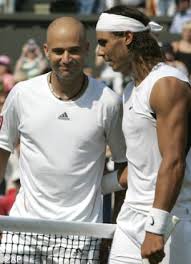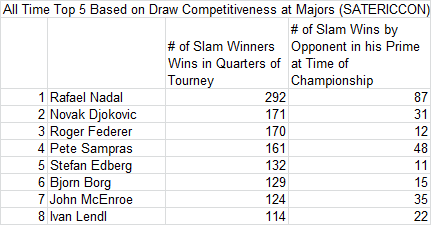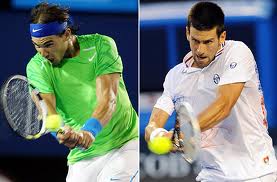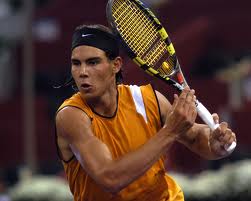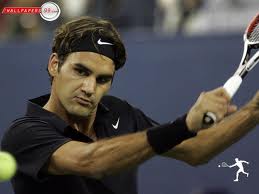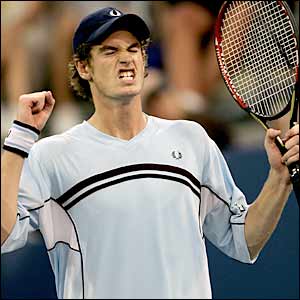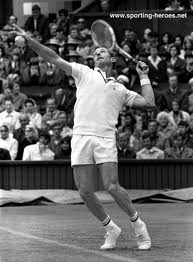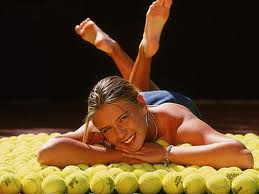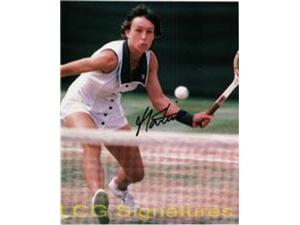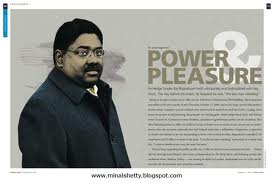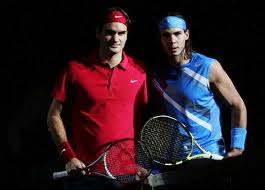Recently Andre Agassi said that Rafael Nadal was the greatest tennis player of all time. As if he was a reader of our blog, he said (1) “I’d put Nadal No. 1, Federer No. 2,”, (2) “Nadal had to deal with Federer, (Novak) Djokovic, (Andy) Murray in the golden age of tennis. He has done what he has done and he’s not done yet.” And (3) “It’s just remarkable to me what he has done, and he has done it all during Federer’s prime.” Perhaps no one would be better qualified to answer that question as Agassi dominated Federer 3-0 before he got too old at 33 to last a full match with him.
With Agassi’s impetus, we revisit our prior metrics established for player performance over their careers. In particular our methodology which is called the “Secada Tennis Equivalency Rating” or STER.
Echoing Agassi, Roger Federer has 17 grand slam wins. A record unlikely to be equalled according to John Ryle and the folks at 538. Rafael Nadal has 14 grand slams. Nadal has won slams on 3 different surfaces twice and 9 French Opens. Records unlikely to be equalled.
In such a great debate, most people would ask what was the head to head between the rivals. As in the Super Bowl or the NCAA basketball championships, the person who wins is usually the better player. A great argument for tennis’ lack of popularity as a sport among viewers is that this is not the case in tennis, 1+1 is not 2. Almost all tennis columnists argue Federer is the greatest. A few others are fence sitters on this topic and Rafael Nadal is treated by the sports media like Pancho Gonzalez was 60 years ago by the tennis world. Few of these journalists were ever tournament tennis players and even fewer have any sort of quantitative background. None can admit they missed the tennis story of the 21st century which is Rafael Nadal’s all time greatness.
Below, we take a deeper dive into the data focusing primarily on Nadal and Federer.
Nadal vs. Federer Rivalry
Most tennis journalists and commentators who look at the Nadal – Federer rivalry shrug off Nadal’s 23-10 dominance. But two facts show Nadal’s absolute domination which is greater than the actual record. Grass court tennis (Wimbledon) is played about 4 weeks during the tennis year and indoor tennis primarily the Masters, is played for 4-6 weeks during the tennis year. So in a year of tennis about 80% of the tennis is played on hard courts or clay. Nadal’s record vs. Federer on those surfaces is 9-2 on Hard Courts and 13-2 on Clay. 4 of Federer’s wins against Nadal have been indoors where Nadal is ineffective and 2 have come on Grass where Federer has not beaten Nadal since he was 21. So for about 80% of the tennis season Nadal is an overwhelming favorite to beat Federer 85% of the time.
As we discussed in a prior blog post, Federer has not had a tournament win in a grand slam against Nadal since Nadal was 21. And Nadal has beaten Federer the last time they played in the finals of every slam on every surface. So a betting person would see Nadal as the odds-on favorite on every surface against Federer except indoors where tennis is rarely played.
Inside the Federer – Nadal Match
But what about inside the match? We developed a new metric to quantify the difference between Nadal and Federer. Federer usually holds an advantage in aces and service winners against Nadal, but what happens when the point gets into play? If Nadal gets the ball back, what chance does Federer have in the point? We created the Secada Point Differential, Less Ace Differential (SPODLAD) metric to account for this. SPODLAD is simply the calculation of point differential per match i.e. the difference in points won per match, less the ace differential per match. Prior to Nadal’s turning 22 Nadal’s SPODLAD vs. Federer in matches he won was about 13 points.
Since turning 22, Nadal’s average SPODLAD vs. Federer in wins has widened to a 20 point advantage. So since learning how to beat Federer in his early years, it has become much easier. In 85% of Federer’s hard court and clay court matches against Nadal, he starts at a 20 point disadvantage off serve which is like being 1-2 points behind every game in a 2 set match. Why play the match, just bring the shellac!
Indeed in Federer’s 2007 Wimbledon win against Nadal, Nadal had a superior SPODLAD of 16 but Federer served 23 more aces and several more service winners to provide the winning margin. You might say, “Eureka, that’s it, Federer has a great serve”, but he doesn’t. Federer hasn’t had a 20 Ace differential match against Nadal since the 2008 Wimbledon. The Ace differential since then is about 5 Aces per match in wins or losses. Note: Federer’s serve has not improved speedwise since 2007 while Nadal has added 10 miles per hour to his serve on faster services. Even more telling, Federer’s SPODLAD in wins against Nadal is 6 in his career and when eliminating indoor tourneys is less than 3. When Federer wins, it is by the skin of his teeth.
Comparative Slam Victories
We dug even deeper. What about the 17 grand slams Federer has vs. Nadal’s 14. Critics say that matters. To measure that, we developed the Secada Finals Efficiency Rating (SFER).
In the past we have used the Secada Total Opponent Slams (STOS) as a measure of the quality of the opponent a slam winner beat in the finals. STOS takes the number of slams an opponent has won during the career and assigns a numerical power rating to that number. So in 17 Slams Federer’s opponents have won a respectable total of 55 grand slams in their careers or about 3 career slams on average. Meanwhile, Nadal’s opponents have won 124 grand slams between them or about 9 slams on average. Nadal is 6-2 vs Federer at Slam finals and has not lost to him at a slam final since he was 21 years old.
But world renowned tennis historian, Phil Secada, suggested we look at the actual Grand Slam championships won at that point in time by opponents and zeroed out the slams won against champions past their prime (Andre Agassi) and slams not yet won. We call this the Secada Finals Efficiency Rating for Power (SFERP). In other words, SFERP takes the number of slams won by the champion’s opponents only up until that point in time to normalize the data for relative match experience.
And Nadal continues to impress. His opponents still have a record 87 grand slams under their belts between them as Nadal has beaten Djokovic twice since Djokovic’s 6th grand slam victory and Federer 4 times since his 12th slam.
But Federer’s SFERP rating of 12 tell a different story.
New York Times Wine Diarist and Sommelier Journal writer – Michael Steinberger (seriously, tennis is that unpopular, no really) claims Federer is the all time greatest because he set records against chumps and babies. Federer has no championship wins against all time great players in their prime. Federer’s wins against Murray and Djokovic in Slam finals was before they won a slam. Just because somebody won during a weak year doesn’t mean that year (that title) is as good as someone who won during a great year. In layman’s terms “Shakespeare in Love” won the Academy Award in a weak movie year. Does that make it as good as “Gone With the Wind” or “Titanic” or “Gladiator” that all won out over other great movies? HECK NO! In tennis parlance, John McEnroe’s Wimbledon victory over 5 time defending champion Bjorn Borg is far greater than Pat Cash’s win over non titlist Ivan Lendl. OF COURSE!
How About Federer vs. Djokovic?
Federer never beat a player with more than 3 slam victories in the finals of a slam and once he has lost to a player at a slam final he has not beaten that person again at the same slam. In contrast, after Nadal lost to Djokovic at the 2011 US Open, he came back and defeated Djokovic at the 2013 final. Nadal has beaten players with more than 3 slam victories in their prime at 9 slam finals, another record! The next closest are Ivan Lendl and Sampras with 4 finals wins against players with more than 3 slam victories. And Djokovic’s Ascension to arguably the #1 player the last 4 years has had an impact on Nadal. The last time we calculated all time winning percent against all time greats, Nadal was #1 with a 66% rate. Since then and with several losses to Djokovic, Nadal is now #4 in all time winning percent against other all time greats at 57.8%. And we expect Nadal’s winning percent to continue to decline against the younger Djokovic.
What about other measures. SITDON and SATERICCON are quantitative, analytical metrics created to measure the body of a tennis players career as a whole vs. the field. It looks at the Grand Slam championships of rivals in the tournament and rivals played. As your opponents records improve, your own ranking goes up. According to our SITDON and SATERICCON 2014 All Time Rankings, Federer has finally surpassed Pete Sampras as an all court champion. But, Federer himself has been surpassed as an all court champion by Novak Djokovic. On a total points basis Rafael Nadal is way out in front with 292 points, Federer has 170 points but Novak Djokovic has 171 points. Pete Sampras has 161 points.
Djokovic has rocketed ahead based on superior competition in tournaments he has won including this year’s Wimbledon. We expect, with little competition in sight and a game like Agassi’s built to last, Djokovic will win a few more fast surface slams before his career is over putting him far ahead of Federer. Again, below are all time rankings based on draw competitiveness. Of players with more than 6 championships in our top 8 rankings based on tournament competitiveness, Federer has won against the weakest finalists in aggregate. Nadal has won against the strongest finalists followed by Sampras, McEnroe and Djokovic.
With this data, now ask any one of these commentators if their money was on the line in a head to head who would they bet on and it would be Nadal. What about the third best player of the era, Novak Djokovic. In the last 5 years, Federer is 2-4 in slams against the Djoker (6-6 all time), Nadal is 5-3 vs. Djoker in the same period and 9-3 overall. So who would you bet to have the best chance against the third best player of the era at their prime? So right, you would bet against Federer playing Nadal and Djoker, but Federer is the best?!? HE ISN’T!!!If Federer isn’t the best of his era by 2, he can’t he be the best of all time.

